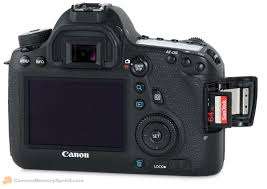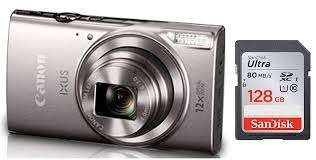SD Cards for Canon Cameras
Introduction
in the SD Cards for canon Cameras For dependable storage, quick data transfer, and seamless operation, selecting the appropriate SD card for a Canon camera is essential. Choosing the greatest SD card can greatly improve your productivity, whether you are a professional photographer taking high-resolution photos or a videographer recording 4K or 8K footage.
Everything you need to know about SD cards for Canon cameras will be covered in this post, including types, storage capacity, speed ratings, and suggestions for the top SD cards of 2025. Tell us in detail.
FAT format will be used for cards with a size of 128 GB or less. Cards larger than 128 GB will be created using the exFAT format. An error message may appear, and the card may become unusable if you format a card larger than 128 GB with this camera and then put it into another camera.
SD Card Types and Compatibility
There are three main types of SD cards:
• Secure Digital (SD): Utilizes the FAT16 file system and supports up to 2GB of storage.
• Secure Digital High Capacity (SDHC): Utilizes the FAT32 file system and has a 4GB to 32GB capacity.
• Secure Digital Extended Capacity, or SDXC, uses the exFAT file system to provide capacity up to 2TB, which is more than 32GB.
The compatibility of SD cards varies depending on the device’s capabilities; older devices may have limits. SD cards exist in many varieties (SD, SDHC, SDXC, and SDUC) with varied capacities and speeds.
The types of SD cards and their compatibility are broken down as follows:
Types of SD Cards:
SD (Secure Digital): Up to 2 GB of standard capacity.
With a higher capacity than SD, SDHC (Secure Digital High Capacity) has a 4GB to 32GB storage range.
Secure Digital eXtended Capacity, or SDXC, provides considerably more storage space, with capacities ranging from 64GB to 2 TB.
The most recent standard, Secure Digital Ultra Capacity (SDUC), was introduced in 2018 and offers capacities of up to 128 TB, which exceeds 2 TB.
Compatibility:
SDHC and SD devices are backward compatible with SDXC cards.
SDHC cards could be used with SD devices in the past.
Only SD cards can be used with SD devices.
SD and SDHC cards are compatible with SDHC devices.
SD, SDHC, and SDXC cards are compatible with SDXC devices.
Only SDUC host devices are compatible with SDUC cards.
SDHC and SDXC cards might not work with older devices.
When an adapter is utilized, microSD cards can be used in SD card slots, albeit performance might be impacted.
Always check the device’s specifications for the supported SD card types and maximum capacity.
Key Considerations When Choosing an SD Card:
Capacity:
Taking into account the kind of data you plan to save (pictures, videos, apps), pick a memory card with the capacity that best suits your requirements.
Even though SDHC cards are also compatible, SDXC UHS-II cards are usually advised, particularly for frequent continuous photography or video recording. ExFAT is advised for cards greater than 32 GB, while FAT32 is recommended for cards smaller than 32 GB.
Speed:
You should think about using UHS (Ultra High Speed) cards (U1 or U3) or Video Speed Classes (V6, V10, V30, etc.) for high-resolution video recording and quick data transfer.
Application Performance Class (A1 or A2): For better performance in your job, take into account A1 or A2 ratings if you intend to execute programs from the SD card.
SDXC cards are the ideal option for contemporary Canon cameras because of their higher storage space and ability to handle high-resolution files.
Canon Camera Compatibility
Different SD card types are supported by various SD cards for Canon camera models. To ensure compatibility, always consult the handbook that comes with your camera. For best results, the latest Canon DSLR and mirrorless cameras accept UHS-I and UHS-II SDXC cards.
SD Card Speed Ratings Explained
The minimum sustained write speed in MB/s is represented by SD card speed ratings, which are denoted by symbols such as “C” (speed class), “U” (UHS speed class), and “V” (video speed class). These ratings are essential for operations like video recording.
This is a summary:
Class of Speed (C):
shown by a number enclosed in a “C” (C10, for example).
represents the MB/s minimum sustained write speed (C10 = 10 MB/s, for example).
C2 (2 MB/s), C4 (4 MB/s), C6 (6 MB/s), and C10 (10 MB/s) are typical ratings.
Class of UHS Speed (U):
shown by a number enclosed in a “U” (U1, U3, etc.).
is the lowest sustained write speed, expressed in MB/s, times 10 (for example, U3 = 30 MB/s).
U1 (10 MB/s) and U3 (30 MB/s) are common ratings.
Class of Video Speed (V):
Shown by the letter “V” followed by a number (e.g., V30, V60).
indicates the lowest sustained write speed in MB/s (V30 = 30 MB/s, for example).
Typical ratings are V6, V10, V30, V60, and V90.
Additional Notes:
For faster speeds, UHS cards (U1 and U3) use the UHS-I or UHS-II bus.
The highest read speed of non-UHS SD cards is 25 MB/s, but UHS-I and UHS-II cards can achieve 104 MB/s and 312 MB/s, respectively.
Although the card frequently displays the fastest possible read speed, consistent write speed is more crucial for dependability.
What is the ideal speed rating for your Canon camera?
• UHS-I or UHS-II with at least Class 10 for JPEG/RAW photography
• V60 or V90 is advised for 8K video recording; V30 or higher is recommended for 4K video recording.
Best SD Cards for Canon Cameras in 2025
1. The best SD card overall
128GB SanDisk Extreme PRO UHS-II
300/s is the read speed.
Speed of Writing: 260 MB/s
Perfect for burst photography and 4K or 8K video
Rapid pictures, sequential burst mode, and RAW capture are easily handled by SanDisk Extreme PRO SD UHS-II cards’ write speeds of up to 260 MB/s*, while transfer speeds of up to 300 MB/s* are made possible for workflow efficiency.
2. The Best Low-Cost SD Card
64GB Kingston Canvas React Plus
170/s is the read speed.
90 MB/s is the write speed.
Excellent for Full HD video and general photos
The Canvas GO! Plus microSD card speeds up your productivity and efficiency with exceptional transfer speeds of up to 170 MB/s, giving you more time to explore your creativity.
When using a slow SD card in your Canon camera, especially when shooting high-resolution or high-frame-rate videos, you may experience longer buffer clearing times, reduced burst shooting capability, and potential video recording issues.
3. Best SD Card for 4K and 8K Video
Lexar Professional 2000x UHS-II (256GB)
Read Speed: 300/s
Write Speed: 260 MB/s
Ideal for producing high-resolution videos
With read rates of up to 300 MB/s, Lexar® Professional 2000x UHS-II (256GB) SD cards significantly speed up your workflow² from beginning to end. You can simply handle RAW and JPEG and sequential burst mode with write speeds of up to 260 MB/s, ensuring you never miss a shot.
4. The Greatest SD Card for Expert Photographers
The 128GB Sony TOUGH-G Series
Read Speed: 300/s
Write Speed: 299/s
Class 3 (UHS Speed Class),
Class 10 (SD Speed Class),
V90 (Video Speed Class) is the three-speed class.
interface
UHS-II
incredibly resilient and water-resistant
5. The Greatest SD Card for Sports and Wildlife Photography
Digital SDXC UHS-II Pro Grade (256GB)
Read Speed: 250 MB/s
Write Speed: 200 MB/s
Great for high-speed photos and burst photography
The best option for wildlife photography is frequently SDXC cards. This is the reason: SDXC cards have capacities ranging from 64GB to an incredible 2TB. With capacities ranging from 64GB to 256GB, our professional SDXC cards offer plenty of room for a full day of shooting.
How to Choose the Right SD Card for Canon Camera
1. Consider Your Needs for Photography
If you take 4K films or RAW photos, choose SDXC cards with a high capacity and speed. UHS-I SDHC cards are an option for amateur photographers.
2. Check the specifications of your camera.
• Canon EOS R5 and other advanced models are compatible with UHS-II/V90 cards, whereas older models might not support them.
3. Balance Between Storage and Speed
For professional use, 128GB to 256GB is perfect.
32GB to 64GB is sufficient for casual photographers.
How do I know if an SD card is compatible with my Canon camera? Check the user manual or the Canon website for the maximum storage capacity, suggested speed class, and supported memory card types (SDHC, SDXC, etc.) to make sure your SD card is compatible with your SD cards for a Canon camera.
How to Properly Maintain Your SD Card
1. Regularly format your SD card. To maximize performance, format in-camera.
2. Safely Store Your SD Cards
• To prevent damage, use protective cases.
3. Avoid Common SD Card Issues
• When writing, keep the card in place.
• Make regular file backups.
Conclusion
Selecting the right SD card for your Canon camera can significantly impact its efficiency, dependability, and performance. Whether you’re a professional photographer taking high-resolution photos or a videographer recording 4K video, choosing a high-speed, high-capacity SD card guarantees seamless operation and guards against data loss. Always take into account elements such as storage capacity, UHS rating, and speed class to suit your unique shooting requirements.
Investing in a high-quality SD card from reliable companies like Sony, Lexar, or SanDisk can improve workflow and protect your priceless assets. Your SD cards will also last longer and continue to function at their best if you handle, format, and store them properly.
With careful selection, you can get the most out of your Canon camera and uninterruptedly take beautiful pictures and films. For years to come, flawless shooting experiences will be guaranteed with the correct SD card, regardless of your preference for a high-performance or low-cost model.
FAQs
1. What SD card format is best for Canon cameras?
While SDHC cards are also compatible, SDXC UHS-II cards are generally advised, particularly for video recording or frequent continuous photography. SD cards are typically for older cameras. ExFAT is advised for cards over 32 GB, and FAT32 is used for cards under 32 GB.
2. How do I know if an SD card is compatible with my Canon camera?
Check the user manual or the Canon website for the maximum storage capacity, suggested speed class, and supported memory card types (SDHC, SDXC, etc.) to make sure your SD card is compatible with your Canon camera.
3. What happens if I use a slow SD card in my Canon camera?
When using a slow SD card in your Canon camera, especially when shooting high-resolution or high-frame-rate videos, you may experience longer buffer clearing times, reduced burst shooting capability, and potential video recording issues.
4. How often should I format my SD card?
You should format your SD card frequently, ideally every two to three weeks or after every transfer, if you use it for continuous recording or in a camera that is susceptible to file corruption.
5. Can I use a microSD card with an adapter in a Canon camera?
Technically, it is possible to use a microSD card with an adapter in a Canon camera, but due to potential issues with compatibility, data transfer speeds, and reliability, this is not usually recommended.
6. What is the ideal speed rating for your Canon camera?
For JPEG/RAW photography, UHS-I or UHS-II with at least Class 10 is recommended. For 8K video recording, V60 or V90 is suggested; for 4K video recording, V30 or above is encouraged.
6.Which Speed Rating is Best for Your Canon Camera?
• For photography (JPEG/RAW): UHS-I or UHS-II with at least Class 10
• For 4K video recording: V30 or higher
• For 8K video recording: V60 or V90 is recommended






